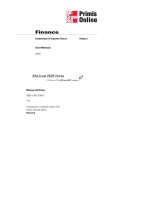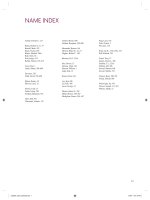Lecture Fundamentals of corporate finance: Lecture 22 - Ross, Westerfield, Jordan
Bạn đang xem bản rút gọn của tài liệu. Xem và tải ngay bản đầy đủ của tài liệu tại đây (763.22 KB, 18 trang )
Chapter
TwentyTwo
International
Corporate Finance
© 2003 The McGrawHill Companies, Inc. All rights reserved.
22.2
Domestic Financial Management and
International Financial Management
• Considerations in International Financial
Management
– Have to consider the effect of exchange rates when
operating in more than one currency
– Have to consider the political risk associated with
actions of foreign governments
– More financing opportunities when you consider
the international capital markets and this may
reduce the firm’s cost of capital
McGrawHill/Irwin
© 2003 The McGrawHill Companies, Inc. All rights reserved.
22.3
Global Capital Markets
• The number of exchanges in foreign countries
continues to increase, as does the liquidity on those
exchanges
• Exchanges that allow for the flow of capital are
extremely important to developing countries
• The United States has one of the most developed
capital markets in the world, but foreign markets are
becoming more competitive and are often willing to
try more innovative ways to do business
McGrawHill/Irwin
© 2003 The McGrawHill Companies, Inc. All rights reserved.
22.4
Exchange Rates
• The price of one country’s currency in terms
of another
• Most currency is quoted in terms of dollars
• Consider the following quote:
– France (Franc)
.1460
6.8479
– The first number (.1460) is how many U.S.
dollars it takes to buy 1 French Franc
– The second number (6.8479) is how many
French Francs it takes to buy $1
– The two numbers are reciprocals of each other
(1/6.8479 = .1460)
McGrawHill/Irwin
© 2003 The McGrawHill Companies, Inc. All rights reserved.
22.5
Example: Exchange Rates
• Suppose you have $10,000 . Based on the rates in
Figure 18.1, how many Italian Lira can you buy?
– Exchange rate = 2021.37 Lira per U.S. dollar
– Buy 10,000(2021.37) = 20,213,700 Lira
• Suppose you are visiting London and you want to
buy a souvenir that costs 1000 British pounds. How
much does it cost in U.S. dollars?
– Exchange rate = .6669 pounds per dollar
– Cost = 1000 / .6669 = $1499.48
McGrawHill/Irwin
© 2003 The McGrawHill Companies, Inc. All rights reserved.
22.6
Types of Transactions
• Spot trade – exchange currency immediately
– Spot rate – the exchange rate for an immediate trade
• Forward trade – agree today to exchange currency at
some future date and some specified price (also
called a forward contract)
– Forward rate – the exchange rate specified in the
forward contract
– If the forward rate is higher than the spot rate, the
foreign currency is selling at a premium (when quoted
as $ equivalents)
– If the forward rate is lower than the spot rate, the
foreign currency is selling at a discount
McGrawHill/Irwin
© 2003 The McGrawHill Companies, Inc. All rights reserved.
22.7
Absolute Purchasing Power Parity
• Price of an item is the same regardless of the
currency used to purchase it
• Requirements for absolute PPP to hold
– Transaction costs are zero
– No barriers to trade (no taxes, tariffs, etc.)
– No difference in the commodity between locations
• Absolute PPP rarely holds in practice for
many goods
McGrawHill/Irwin
© 2003 The McGrawHill Companies, Inc. All rights reserved.
22.8
Relative Purchasing Power Parity
• Provides information about what causes
changes in exchange rates
• The basic result is that exchange rates depend
on relative inflation between countries
• E(St ) = S0[1 + (hFC – hUS)]t
• Because absolute PPP doesn’t hold for many
goods, we will focus on relative PPP from
here on out
McGrawHill/Irwin
© 2003 The McGrawHill Companies, Inc. All rights reserved.
22.9
Example: PPP
• Suppose the Canadian spot exchange rate is
1.4680 Canadian dollars per U.S. dollar. U.S.
inflation is expected to be 3% per year and
Canadian inflation is expected to be 2%.
– Do you expect the U.S. dollar to appreciate or
depreciate relative to the Canadian dollar?
• Since inflation is higher in the US, we would expect the
US dollar to depreciate relative to the Canadian dollar.
– What is the expected exchange in one year?
• E(S1) = 1.4680[1 + (.02 .03)]1 = 1.4533
McGrawHill/Irwin
© 2003 The McGrawHill Companies, Inc. All rights reserved.
22.10
Interest Rate Parity
• Based on the previous example, there must be
a forward rate that would prevent the arbitrage
opportunity.
• Interest rate parity defines what that forward
rate should be
Exact :
F1
S0
F1
Approx. :
S0
McGrawHill/Irwin
(1
(1
1
RFC )
RUS )
( RFC
RUS )
© 2003 The McGrawHill Companies, Inc. All rights reserved.
22.11
Unbiased Forward Rates
• The current forward rate is an unbiased estimate of
the future spot exchange rate
• This means that on average the forward rate will
equal the future spot rate
– If the forward rate is consistently too high
• Those who want to exchange yen for dollars would only be willing
to transact in the future spot market
• The forward price would have to come down for trades to occur
– If the forward rate is consistently too low
• Those who want to exchange dollars for yen would only be willing
to transact in the future spot market
• The forward price would have to come up for trades to occur
McGrawHill/Irwin
© 2003 The McGrawHill Companies, Inc. All rights reserved.
22.12
Overseas Production: Alternative Approaches
• Home Currency Approach
–
–
–
–
Estimate cash flows in foreign currency
Estimate future exchange rates using UIP
Convert future cash flows to dollars
Discount using domestic required return
• Foreign Currency Approach
– Estimate cash flows in foreign currency
– Use the IFE to convert domestic required return to
foreign required return
– Discount using foreign required return
– Convert NPV to dollars using current spot rate
McGrawHill/Irwin
© 2003 The McGrawHill Companies, Inc. All rights reserved.
22.13
Repatriated Cash Flows
• Often some of the cash generated from a
foreign project must remain in the foreign
country due to restrictions on repatriation
• Repatriation can occur in several ways
– Dividends to parent company
– Management fees for central services
– Royalties on the use of trade names and patents
McGrawHill/Irwin
© 2003 The McGrawHill Companies, Inc. All rights reserved.
22.14
Short-Run Exposure
• Risk from daytoday fluctuations in exchange
rates and the fact that companies have
contracts to buy and sell goods in the shortrun
at fixed prices
• Managing risk
– Enter into a forward agreement to guarantee the
exchange rate
– Use foreign currency options to lock in exchange
rates if they move against you but benefit from
rates if they move in your favor
McGrawHill/Irwin
© 2003 The McGrawHill Companies, Inc. All rights reserved.
22.15
Long-Run Exposure
• Longrun fluctuations come from
unanticipated changes in relative economic
conditions
• Could be due to changes in labor markets or
governments
• More difficult to hedge
• Try to match longrun inflows and outflows in
the currency
• Borrowing in the foreign country may mitigate
some of the problems
McGrawHill/Irwin
© 2003 The McGrawHill Companies, Inc. All rights reserved.
22.16
Translation Exposure
• Income from foreign operations has to be translated
back to U.S. dollars for accounting purposes, even if
foreign currency is not actually converted back to
dollars
• If gains and losses from this translation flowed
through directly to the income statement, there would
be significant volatility in EPS
• Current accounting regulations require that all cash
flows be converted at the prevailing exchange rates
with currency gains and losses accumulated in a
special account within shareholders equity
McGrawHill/Irwin
© 2003 The McGrawHill Companies, Inc. All rights reserved.
22.17
Managing Exchange Rate Risk
• Large multinational firms may need to manage
the exchange rate risk associated with several
different currencies
• The firm needs to consider its net exposure to
currency risk instead of just looking at each
currency separately
• Hedging individual currencies could be
expensive and may actually increase exposure
McGrawHill/Irwin
© 2003 The McGrawHill Companies, Inc. All rights reserved.
22.18
Political Risk
• Changes in value due to political actions in the
foreign country
• Investment in countries that have unstable
governments should require higher returns
• The extent of political risk depends on the nature of
the business
– The more dependent the business is on other
operations within the firm, the less valuable it is to
others
– Natural resource development can be very valuable to
others, especially if much of the ground work in
developing the resource has already been done
• Local financing can often reduce political risk
McGrawHill/Irwin
© 2003 The McGrawHill Companies, Inc. All rights reserved.









